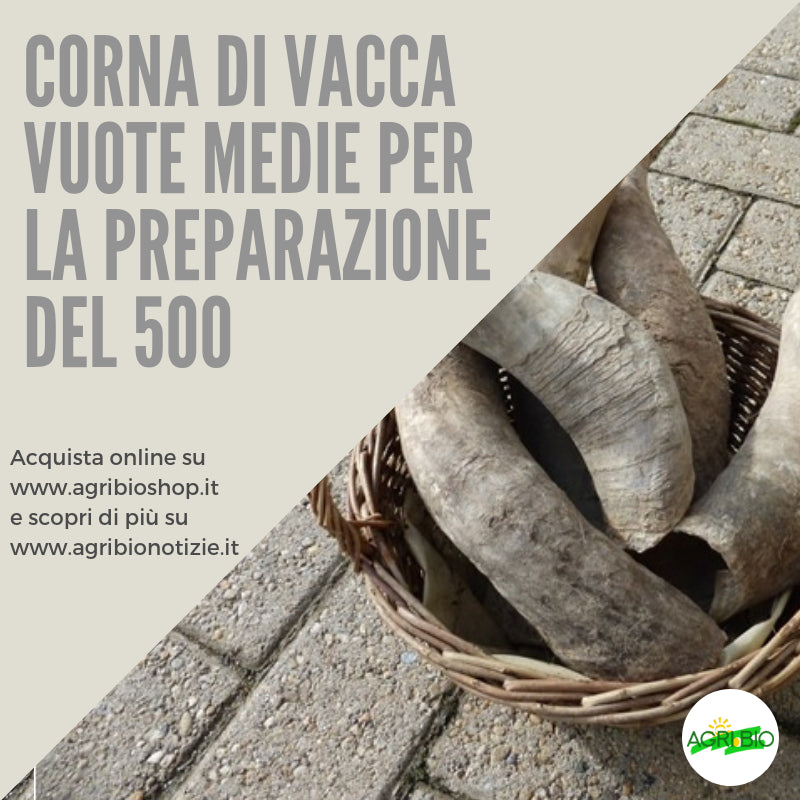Medium hollow horns for 500 setup
Have a question?

Medium hollow horns for 500 setup
Dettagli
THE HORNS FOR PREPARING SPRAY PREPARATIONS
One of the tools fundamental for preparing biodynamic spray preparations (500 and 501) are the horns: it is necessary to find the right horns and in sufficient quantities. They must be female bovine, commonly referred to as a "cow". Bovine horns are made of keratin and are supported by the frontal bones, of the protuberances of the skull, also called frontal sinuses.
The requirements of these horns must correspond as much as possible to the original characteristics and, therefore, must not be deteriorated, damaged, worn or frayed following traumatic events or wear. And they must not undergo alterations through chemical agents, boiling, pasteurization or anything else.
The horns must come from specimens that have calved at least once, R. Steiner indicated that the best horns were from cows that had calved 3 to 8 times.
The size of the horn is not relevant, also because practice has shown a better transformation of the manure inside medium-small sized horns rather than in large horns, where the content often does not transform well, while the shape of the horn will have to be as close as possible to the characteristics of the species and, as a whole, harmonious, possibly with a spiral growth movement. Horns of 10 cm and above are perfect for setting up the 500.
The horns used to prepare cornolet manure can be reused for several years: up to 5-6 years if well preserved. The horns worn and worn out over time can no longer be used to prepare the preparation and it is understood that they can no longer be used because they become soft, yes they become frayed or punctured and become light.
While the horns used to prepare the preparation 501 (Cornosilice) must be used only once: I recommend reusing the horn used for the 501 to set up the 500.
We also have beautiful Egyptian cow horns available which are 50 to 60 cm long and have an opening diameter of 5-6 cm and which contain up to 10 times the contents of an Italian cow.
I recommend, even for those who make horn manure for a small company, to use at least a minimum of 15-20 horns, because based on experience, with just a few horns the preparation does not always transform well.
Today it is not a simple thing to find horns, due to various problems: the first is that within a few decades cows will already be born without horns, as for decades they have been considered by farmers and veterinarians to be useless "tools" for the cows themselves and are cauterized with dehorners which with temperatures of 700° and guarantee not to create pain, nor to cause damage or cause stress to the animal (!!!); this practice is authorized of course by the competent veterinary bodies as a healthy and natural and non-invasive veterinary practice, which is absolutely false, since, as explained R. Steiner himself and anthroposophical veterinarians, an important function of horns for cows is to aid digestion, being catalysts of astral and etheric forces which are conveyed into the stomach of the ruminant through the same horns, and are also organs of sense and orientation of the animal itself. The second reason is that due to the use of special "dehorning creams" already at the birth of the calves today many cows no longer have horns from birth!
First the horns to set up the 500 they must ONLY be from cows, i.e. cows that have had calves, because in this way the cow is fully in relation to the reproductive lunar sphere: from my many experiences the horns of bulls or heifers do not completely transform the contents inside. Cow horns they have grooves, rings on the base of the horn which they enumerate their pregnancies.
The horns taken from the slaughterhouse still have the frontal sinus (the bone) inserted into the horn and must be buried for approximately 20-30 days in moist soil so that the bacteria and microorganisms in the soil, nourishing themselves on the blood and organic substances, create the conditions to bring out the same frontal sinus, freeing the horn: for this reason the horns ready for use that we distribute, they remain a little dirty with earth from the outside, especially if it rained a lot during the burial period, the important thing is that they are clean inside, where the made will be inserted.
Be wary of horns that are perfectly clean on the outside, because it means that they have most likely been boiled to extract the frontal sinus, and with this procedure the "maturing" characteristics of the horn have literally and physically been fried.
The horns so they are ready and they come stored for use in a fresh warehouse and darkness in breathable bags: it is important that in the period which elapses between the extraction of the horn manure and the following burial (April – September) do not receive light and/or rain which would quickly degrade them.
Longer and larger horns are usually used to set up the 501 (silica horn), while medium and small horns are good for the 500 (manure horn).
Usually everyone would like to have very large horns, but I have to tell you from experience that often the one made with too large horns does not always turn out well.
Sconti sul volume
| Quantità | Sconto | Salva |
| 31 | 5% | Fino a 5,97€ |
| 201 | 10% | Fino a 77,39€ |


